|
“What is your superpower?”
– Dr Jenine Beekhuyzen, Founder and Director of the TechGirls are Super Heroes Movement
Welcome back to my review of the FutureSchools conference. Today I will begin reviewing the ClassTech Conference Stream which I attended. If you have missed the previous articles, you can find them here.
I elected to attend the ClassTech conference for FutureSchools2016, having attended the same conference in 2015 as I felt that it was still the best fit for me and where I am, currently, in my teaching career. Day One of the ClassTech conference (Day Two for FutureSchools2016 overall) began with a welcome by Dr Jenine Beekhuyzen, who is the founder and Director of the TechGirls are Super Heroes movement (@TGAsuperheroes), and her introduction of our first speaker, Anita L’Enfant who spoke, briefly, under the title of Discover Authentic Learning in the Makers Playground. Anita’s talk was very short, approximately fifteen minutes and the two main notes that I have from that talk were that authentic learning, for her, was learning that was relevant, involved real-world problem-solving, was meaningful and was useful. Being relevant does not mean that it has to be relevant to their immediate area; just that it had to be relevant to them in some fashion. The other key point was in relation to safe internet usage. Anita related that everyone in her house uses the internet, as is the case in many households and that part of the discussion around the internet involved ensuring safe usage. She spoke about a pair of websites (one aimed at parents and teachers and the other at students) called Think u know which has been developed by the Australian Federal Police (AFP) in an effort to provide useful information about using the internet safely, particularly in regards to the various forms of social media.
I did visit the AFP stand on the FutureSchools Expo floor and spoke with the Officers running it (yes, they had actual AFP Officers there) and they spoke about how the information and handouts on various forms of social media that were currently popular (such as Instagram, SnapChat, Kik and Twitter) had been developed based upon what they had learned as a result of incidents that had come to the attention of various Police Agencies. The leaflets they had on the desk were available in both adult-friendly and student-friendly form on the respective websites. I do believe that the resources put together are well worth using as a way of teaching students about cyber-safety in particular forms of social media as, despite the required age to register being thirteen years old, I know of a number of my students who have and use social media such as Instagram, Snapchat and Twitter.
After Anita had spoken, we were introduced to our first keynote speaker, Jennie Magiera, and while a lot of what she said I had heard the previous day during the master class, there were some points of difference. Jennie opened with a quote from J.R.R. Tolkien: “I am looking for someone to share an adventure that I am arranging,” which she used to launch into a discussion around the Polynesian seafarers who left their homeland centuries ago to discover what was beyond the horizon and the fact that all they would have been able to see from their home shores, which is apparently believed to be Taiwan, was the sea, and so they were taking a big risk.
These seafarers were leaving behind two types of people and were themselves a third type of people, which neatly fits into the Rogers’ Curve for Early Adoption. There were the Innovators, which Jennie referred to as the hooray! group; those in the middle of the bell-curve, the large majority of people, whom Jennie referred to as the hmmm group, and then finally the laggards, who were dubbed the heck no! group.
We are used to thinking about early adopters of technology when we discuss the Rogers’ Curve for Early Adoption and typically the discussion is focused on the innovators or early adopters, with little thought or discussion of the remainder of Rogers’ bell curve. Jennie’s talk, however, focused on those people who are seemingly oft-forgotten in talks at conferences or are discussed in simple reference to how we, as innovators or early adopters of technology, need to drag them to where we are.
Jennie asked us to consider that the laggards are often saying “I cannot….” out of fear or disbelief. The point being made here was that rather than admonish the laggards for not being on board, as often happens, we should instead take a leaf from the Polynesian early explorers. It was pointed out that they had to have said something powerful to convince others to join them on their exploration voyages. What can we say to the laggards around us to convince them to start their adoption of technology, and support them along the way.
Jennie then continued to outline some steps for ensuring a good Edventure (her use of puns was high and deliberate…and fun!) and she said that we need to find a crew; gather those around us who are on the same page, willing to learn, or who will support us, even if they do not wish to be involved actively. We need to name the ‘ship’ that we are edventuring aboard, take the obligatory pre-voyage selfie and then our briefing needs to include that we need to make sure that students fail and fail often.
Jennie elaborated on this point by reminding us that we are often told that we need to ensure our students are successful, whether it is in testing, in sports or socially; that it is our responsibility as teachers to ensure they experience success. Jennie (and I, for what it is worth) disagree. It is in the iteration and reflection upon failure that learning can occur. The acronym FAIL, meaning First Attempt in Learning should lead, with reflection and constructive feedback from the teacher to SAIL, or the Second Attempt in Learning. We need to allow our students to fail so that they learn how to fail. Failing is part of life, whether it is a test, or not getting the job or promotion you wanted. Jennie continued by asking us to let go, commenting that “like all fascist dictators, even though we think that it is for the greater good of our students, it is not.” We do not need to micromanage each stage of learning for the students.
Jennie’s next piece of advice was that we need to charm our inner student. We forget to be gleeful and to allow our lessons to be gleeful. If we are not enjoying a lesson, chances are that our students are not either. Following on, Jennie reminded us, again, that innovation is an ongoing process and that we should not judge others for their starting point, which generated an interesting conversation with Rhoni McFarlane (@rhonimcfarlane) via Twitter on this subject:
I believe that although it appears we were coming from different places, that ultimately, Rhoni and I are on the same page in regards to supporting the laggards, those who are reluctant to take up technology in the classroom, we need to do so from their starting point, as Rhoni puts it, “we need to meet them where they are.” Though we are most likely technology leaders, and the laggards around us perhaps see us as some kind of mystical technology wizard, we need to remember that the basic and mundane for us is likely equivalent to Jedi mind-tricks for them. Innovation is a never-ending continuum and we have to start somewhere.
Following this was a reminder to audit our innovations. Jennie spoke about how the recent National Education Technology Plan (#NETP16) noted that authentic learning in non-technological contexts abounds if we let go of our assumptions. Often as leaders, we operate in a bubble, an echo chamber, that is impenetrable to the heck no group. We need to emerge from that bubble and audit the answer to why are we a proponent of this piece of technology? Jennie encouraged us to teach beyond the standards, to go above and beyond and spoke about her Year Four students, who surveyed other students about how they could give back to their community, with the typical response being “we can’t, we’re just kids.” Her students subsequently made a video with the core message “no matter how small you are, or how small the change is, yes, we can [make a change].”
Following this was a reminder that as the Polynesian’s reached each island on their voyage, they did not stop there and rest on their laurels, they kept going to see what impossible goal they could achieve next. Jennie spoke about introducing Google Explorations to a class for the first time and having a student exclaim that “I can’t wait to tell my parents where I’ve been today!” Not that the student said where she had been, not what she had learned. The what will be embedded, but for the student, the where is the immediate thing of importance.
Jennie’s final note was that we need to “share our crazy pills,” that whatever it is that excites us, our “poison of innovation. Rebecca Hepworth (@bechep2) put it succinctly via Twitter:
The vibe in the room at the end of Jennie’s keynote was energetic and invigorated. Jennie is a fantastically engaging speaker, and as you can see, despite having experienced a master class with her the previous day, I still learned a lot from this keynote.
There are still two speakers to review from session one, so I will close out this article now, and focus on the talks from Cathie Howe and Jill Margerson in tomorrow’s article. As always, thank you for reading, and I would appreciate any feedback or thoughts on this article or the ideas contained therein. You can find the other articles in this series by clicking here.
0 Comments
Welcome back for my review of session three of Jennie Magiera’s master class at FutureSchools 2016. If you have missed the previous two articles, you can read about session one here and session two here. The day to this point had been full of energy and excitement, had been engaging and for me, personally, very much worthwhile attending. I feel that the badging concept discussed in session two was something that I could potentially implement in my classroom whereas when I have heard about badging in the past, such as here, I have been left feeling that it falls into the too hard basket. This session, however, was full of activities that I feel confident that I could take back to my school and implement in either the staffroom or the classroom, within the appropriate context. Jennie spoke about IEP’s, or Individual Education Plans, a document utilised to help with planning for and making adjustments for students with additional needs (whether that be below or above the grade standard) and how they are a document often perceived negatively and that we need to change that perception by using them positively, for ourselves as teachers, as a method of focusing on a single problem, what Jennie termed a problem of practice. When Jennie first entered the role of Chief Technology Officer (CTO) within her school district in the United States, she said that she found she would enter a school and that teachers there would literally turn and run in the opposite direction; “she’s the tech lady who’s here to make us use tech!” Jennie wanted, and needed, a way of changing the perception of technology in education, this ethereal and magical thing that Jennie heard teachers downplay their self-efficacy with “I’m no good at technology.” It is a refrain that I have heard far too often. The Teacher Individual Exploration Plan (TIEP) that Jennie formulates is a different approach to thinking about technology in the hands of teachers. The object is to shift the focus from getting better with technology to getting better as educators. The second goal is one that we should all be striving for, one which teachers the world over invest time and money out of their own account, investing in their ability to be a better teacher. Jennie came up with what she called gripe jam. Gripe jam is a process which consists of every teacher in the room having a stack of post-it notes (side-story: Jennie found that having too many post-it notes in your luggage registers as bomb-components with customs! Apparently it has something to do with the adhesive used on them), and when presented with various daily scenarios, the teachers write down all the problems they encounter in that scenario with one problem per post-it note, and generally only one to two minutes per scenario. We all complain about something in our lives, but when was the last time you were not only given permission, but encouraged to do so? The scenarios were daily situations that she refers to as problem catalysts, linking this process to the wonder catalyst from session one, and were typical situations that any teacher would be able to relate to; arriving first ting in the morning, the middle of the first teaching block, planning / marking time, professional development sessions run by the school, preparing for the start of a new school year etc. The key here, as with the wonder catalyst process, is not to audit the problems. It does not matter what anyone else at your table, in your school or in your district office thinks of that issue, if you perceive it as a problem, than for the purposes of this exercise, it is a problem. Step two involves arranging all of your problems into a continuum from most frustrating to least frustration, in a single line. For this, participants need to spread out so they have approximately an arm-span worth of free space to allow them to order their post-it notes into one continuous line. Jennie indicated that there can be no ties, that you must have a single line of problems, ranking every problem as more or less frustrating as the others. It is also critical here that you rank them based on how frustrating you find the problem. Not your colleagues / students/parents / administrators etc., just your frustration level. The next step turns this ranked list into a scatter plot and is aimed at reflecting on how many people are frustrated by the same thing. If you are the only person who finds something frustrating, then you would move it down the y-axis, if everyone is frustrated by it, then you would move it up the y-axis. This process allows you to reflect on then audit for the purposes of creating the scatter plot, how widespread the impact of this problem is felt within your context, and can end up looking something like this: At this point I was wondering what the point of the exercise was. Despite being intrigued and finding it personally useful to categorise the problems and their relative levels of importance to each other, I could not yet see the overall purpose. The next step was brief; leaving your scatter plot in place, draw a star on those problems that you think you may be able to address or fix with the right resources. This was about looking at a problem and thinking “if I had x then I could probably do y about it, which might resolve part of the issue.”Additionally, we were to place a circle on those problems that we were passionate about, that thing in your school that you see as catastrophic and that you want to engage with and solve where no-one else is interested or sees a problem. This was something that I could understand in terms of its purpose relative to the task and my career as a teacher, and there were a few problems or issues in my scatter plot that, with the right resources and support, I believe I could potentially influence and accordingly added a star to those issues. It was the subsequent step, however, that I found to be the most powerful and useful. With scatter plots in place, indicating how frustrating the issue was to you personally as well as how many people also felt the frustration, with some indication on the post-it notes of your passion or belief about your ability to influence the problem positively, Jennie instructed us to go on a gallery walk. This involved us leaving our scatter plot in place and moving about the room, looking at other people’s scatter plots, looking for two things and leaving a mark on their post-it note, or a post-it note of our own per the image below. Looking at other teachers’ scatter plots and seeing problems that I was facing as well was reassuring; as it meant that I was not alone in facing x, that it was encountered by others, and from conversations with others in the room, I was not the only person who felt relieved in making those observations. The second aspect of the gallery walk was to leave either an idea or our contact details whenever we came across a problem that we felt we could positively contribute to. Personally, I returned to some advice on one of my post-it notes, which I will be able to follow-up on later, and I noticed a number of other scatter plots also had ideas and contact details, hopefully which the owner of the scatter plot found useful. At this point, we returned to the TIEP form, which Jennie has kindly given permission for me to share via the blog, asking that I note that it will be included in her upcoming book, Corageous Edventures. So I include a blank template of the TIEP here for you to access, in Google Doc format. After selecting one problem to focus on, and ignoring the rest for the moment, you need to get to know the problem, detailing as much as you can about what the problem is, factors impacting on the cause or the lack of a solution, what has been tried in the past as a solution to the problem, and what parts of that solution did and did not work as well as why, which looks like this on the TIEP form: Jennie related problems to the radio waves by reminding us that at any given moment there are dozens of radio station signals in the air in a big city, but that it is only by focusing your tuner on one radio band that you can listen to a station clearly. We need to select one problem of practice to focus on, otherwise our attention and effort is diluted across many issues, and each will suffer because of that. Jennie indicated that it is the same with attending conferences, that we should go with one problem of practice to which we want to obtain some ideas, help, tips or solutions for in order to focus our attention, our note-taking, and before all of that, our choice of conference stream and workshop enrolment, a tip that I have heard previously from Kirsty Nash (@NasherK), via Dr Inger Mewburn’s blog The Thesis Whisperer (@thesiswhisperer). This led to a discussion about teacher-led models of professional development. EdCamps are a crowd-sourced model with no presenters’ per-se , which does not need to be done face-to-face as they are now often offered via Google Hangouts. EdCampHome (@edcamphome) offers kits that lay out how to organise and run an EdCamp if that is a route you wish to go down. Further to that, Google Hangouts on the air (GHOTAs) allows you to have up to fifteen actively engaged participants who all have @education.gov accounts. This of course does not take into account the ability for an unlimited number of others to participate via simply watching the GHO and participating via a back-channel such as Twitter (GHOTA FAQ page) A virtual Professional Learning Network (VPLN) is also an important tool to continuously access professional learning on a topic or area that is of interest to you, outside of the professional development that is being offered in your school community. The added bonus here is that you can access a VPLN anywhere and anytime you are connected, which, with the ubiquitous nature of smart phones in society, is essentially anywhere, bring us around to a current buzzphrase: There is one more activity which Jennie took us through, another hands-on process which can be implemented easily in the school, which I will leave for the next article. For now, thank you for reading this, another lengthy article, and as always, I would appreciate any feedback whether here or via Twitter.
View the other articles in this series here. “We forgot the third date!” – Jennie Magiera Welcome back for the last article in my review of the masterclass run by Jennie Magiera as part of FutureSchools 2016. If you have missed the previous articles, you can find them here. This final article will be shorter than the others, I suspect, as it will focus on one particular activity that Jennie took us through, called app speed dating. This activity is an excellent tool for sharing with a large number of people what an app was called, its purpose and how it could be utilised in the classroom. This exercise is also an excellent opportunity for students to show off the apps they love and want to see utilised in the classroom and teach the teachers. In the first instance, it requires willing presenters who know an app inside out and can explain in four minutes what the app is, what it does, why they love it and how they think it could be used in the classroom as a learning tool. Teachers are allocated a random number (according to how many student-presenters there are set up) and start with that number student. In the four minutes allocated, the student delivers their presentation, and if a teacher likes the app and wants to see more, they add it to their dance card. The teachers may only ask questions if there is time at the end, and when the end of the time is up, they must move to the next student-presenter. Jennie related that they had to teach their student presenters in one school to power down like a robot (with the sound effect!) and ignore any teacher who continued to try to ask questions in order to have the exercise proceed smoothly and without large time delays “Teachers are the worst students for not moving on when they’re asked.” -Jennie Magiera The second date is a little more structured and involves teachers having a playdate with one app in which they see the most potential for them to use in the classroom. They are given a specified time-frame (Jennie nominated one hour as the time they use) in which the teacher in that play-date group can play with that app; press buttons, try things out, fail and learn on their own, without intervention or assistance from the student presenter. Jennie made clear that the value in this phase is that the teacher should be learning and experiencing success and failure on their own playing, rather than with the instruction of another. Anyone within that play-date group with prior experience of the app should be focusing on developing it further and trying more advanced things rather than instructing others. The above video is from the EduSlam (@eduslam) YouTube Channel in a Google Hangout session with Jennie where she talks about what App Speed Dating is and you can see some video of it in action. The third date is a concept that arose from a conversation Jennie had with Miriam of LearningBytes.net who reached out to Jennie and said that she had forgotten to include the third date in the overall concept. A little bit of digging found the below excerpt from an entry on the Learning Bytes website about this very topic: “So what happens on the third date? The third date is where the teachers’ trial an App they like in their classroom. Ultimately, this is where they will decide whether they want to go all the way with their chosen App and integrate it into their pedagogy. The PD session next week will incorporate staff who went on the ‘third date’ as a result of participating in the PLAYDATE. They will each have a couple of minutes to present about their favourite App and what happened when they used it in the classroom.” – Miriam Scott. Retrieved from http://tinyurl.com/j3tnzhx on 7 March 2016 So we have the first date, where, as Jennie put it, we meet some of the fish in the sea, the play-date where we get to know the app a bit more and try it out, followed by the third date, which is where we give the app a test run in the class to see how it works out. Jennie said that failure at this point can be an important part in subsequent success as it can create cognitive dissonance, which, when pushed through, can assist in embedding new information into our schema. Jennie placed a caveat on this, however, saying that we need to fail with purpose, to reflect and understand why we failed in order to improve on the next occasion.
Reading through the Learning Bytes blog article, it was interesting to note that Miriam took this one step further, where teachers were required to come back to the following Professional Development session and present, briefly, about the app that they chose to take on the third date. Jennie did note that the whole process can be distilled into a one-hour professional development session, similar to how she put us through the exercise. The first date is dropped off entirely, and the session begins with a playdate. Each teacher is assigned to a table with pre-loaded apps, and teacher’s have thirty minutes, under the same restrictions as in the regular roll-out of the concept, in which to experiment, explore, fail and learn with an app. The members of that table then need to decide who will remain on that table to present to the next group in the rotation, after which, they choose someone from that group to stay and present to the next group. For example, Jill from Group Two might be elected to stay and present on an app to Group One as they rotate into Group Two while Group Two rotates onto Group Three. Jill presents to Group One and then elects someone from that group to stay and present to Group Four while Jill remains with Group One who rotate around again. We did not have time for the full set of rotations, however, I was nominated to present in the first set of rotations about the Google Cultural Institute, and then I heard presenters speak about MoveNote, Canva, YouTube360 and Storybird. After this, we went through some closure activities, sharing with others in a series of rotations how we were feeling at the end of the day, what we had learned over the course of the day and would put into practice, and then general chat. I am very glad that I took the opportunity to attend the master class, and will be speaking with my Principal to see if I can get the ball rolling for the school to fund someone else attending along with myself (I will self-fund again to ensure my ability to go), especially someone who is not particularly keen on technology in the classroom, as if that person attends, gains some insight into the potential and what can be achieved and have the opinion changed, then it could have significant ramifications for the school. It could of course completely backfire, but as the popular saying goes, you have to buy a ticket to win the lottery. As always, thank you for reading and I hope that you have found some benefit from these review articles. Tomorrow I will begin publishing reviews of the ClassTech conference stream I attended this year. I have seen some useful review articles other conference streams (such as this review of the Leadership stream by Michael Eggenhuizen (@M_Eggenhuizen) or this review by Anna DelConte (@annadelconte) on the Young Learners Stream). Find all articles in this series here. “Rubrics are the death of curiosity” – Jennie Magiera Welcome back for part two of my review of Jennie Magiera’s master class, entitled Transforming School Culture: Curiosity Based Learning for Students AND Teachers. Click here to read Part One if you missed it. After returning from the morning break, Jennie returned to the exploration of Wonderable questions. Out of a class discussion around questions from a picture of a garbage truck emptying its contents at a rubbish dump, the what if question that emerged and captured the class’ interest most effectively was what if zombies are real and thought it would have been very easy to generate an entire unit of work based around that topic, Jennie continued exploring the question with the students, until they had generated a focus question; how can you survive the Zombie apocalypse? Jennie took a sidestep here, halting the discussion on the zombie apocalypse to talk about rubrics, leading with the statement that “[r]ubrics are the death of curiosity as they tell students how to wonder, how many lines or minutes to wonder in, what size font to wonder in and students stop wondering about anything outside the literal box of the rubric.” I found this intriguing and given the prescriptive nature of many rubrics I can agree. My initial instinct was to push back, mentally with my rubrics are not like that (I have a preference for single-point rubrics as outlined here by Jennifer Gonzales from Cult of Pedagogy), but I stopped myself to question why single-point rubrics are any different and was unable to answer the question. They may not be quite as prescriptive as multi-point rubrics, however, they still outline specific criteria with specific indicators of success and so they still serve as wonder-killers. Jennie turned us towards badging, which immediately turned my mind to gamification or game-based/inspired learning (which I have written about previously here). As with anything, Jennie told us, badging can be implemented brilliantly or disastrously, but the success of a badging program can be distilled into two areas; the frequency and the level of care. We were asked to consider how many loyalty or discount or frequent purchase cards we have in our wallet and how many of those we actually use on a regular basis. If, for example, you happen to purchase a coffee one day and are given a frequent purchase card of the after you purchase ten coffees, the eleventh is free is free variety, but you do not normally visit that coffee store, or you do not normally drink coffee, then the frequency of use is going to be low and you will not engage with the company meaningfully. This translates into badging in the classroom. If there is little to nor frequency of use or reference to the badging system or program then the students are unlikely to engage with the badging. This leads to care, which is itself based around two sub-factors. Jennie reminded us that there are lots of social situations with these structures that we participate in on a daily basis, particularly in the consumer market where companies make use of influencer marketing encourage people to engage with and purchase the new product. In the classroom context, prizes should be intangible for the sake of sustainability of the badging system (and for the sake of your wallet!), but there does need to be a shift, over time, towards social motivation. Social motivation can be achieved by gaining the support of the influencers in the classroom, as those students will be the ones with influence over the rest of the class and allow you to gain traction and the badging system to embed and become part of the class culture. As a side note, there is an interesting ethical discussion that could be had around this topic and the use of marketing tactics in the classroom in this manner. Jennie did also note that there needs to be a conscious decision as to whether the badges will be digital or physical and that there are plenty of options for both, including Mozilla OpenBadges, Schoology and Credly. As with many things creative in the classroom, you require an activator to set the scene, which, when working through the process of creating a badging system, can come from the task itself. Some of Jennie’s class created the below activator for the task, which was simply an image of a TV with a YouTube video over-layed in place of the TV screen, which was quite effective in generating ideas. Students are used to the structure of video games and the badging or achievement structures therein, and so instigating a badging system in the class, or for a particular unit of work is not necessarily that big a stretch for their imaginations, or for them to grapple with. Another way to gain buy-in is for the students to design the badges and the achievements required to achieve those badges themselves. This is a method that is more applicable to some tasks or activities than others. For the escape from the zombie apocalypse task, the end goal was fairly clear; to escape from the approaching zombies and survive. Knowing this end-goal allowed students to generate a range of achievements that would result in the awarding of an appropriately titled badge and so the students, in their teams, were required to create the badge or achievement title, what was required to achieve the badge, what the evidence would be that the achievement had been completed and the design of the badge and Jennie had us complete this task in our table groups. Here is a screencap of some of what my group came up with. Our group got right into this task, and we realised partway through that we had been going about it thinking as teachers, with some very prescriptive descriptions for what was required, but that what we were putting in the how to achieve it column actually belonged in the evidence column and that we had to rethink our approach. We managed to do this and came up with the above badges, plus some more which were on the next slide in our GSlides document. The next step was for us to complete the task, plan how to escape the zombies and also achieve our own badges, which we had to then make a two-minute presentation to the cohort about, and then using a GForm which Jennie had set up, had to rate how well each group’s plan would allow them to survive the zombie apocalypse and how achievable their badges were.
Jennie closed out session two by stating that the difference between badges and rubrics is that badges are open and based on choice, allowing students to choose what they do while rubrics are prescriptive and tell students what they need to do. Students can choose to continue to the higher level, whereas in a rubric a grade that is less than an A is perceived as a failure by the students. From this point, we went into our lunch break which makes this a convenient place to end this article. As always, thank you for reading, and feel free to leave a comment or contact me on Twitter if you have any further questions or thoughts regarding this article. Find the rest of the articles in this series by clicking here. |
Categories
All
|
Support |
© COPYRIGHT 2015. ALL RIGHTS RESERVED.
|

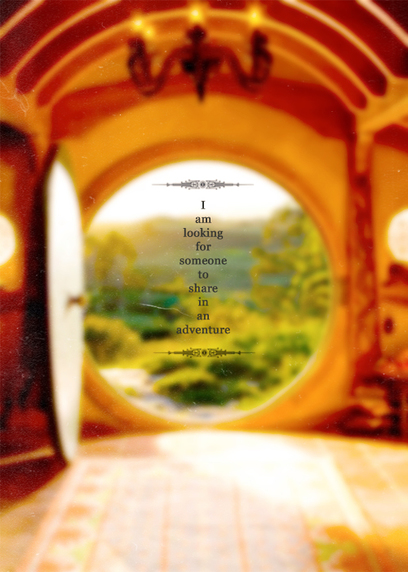

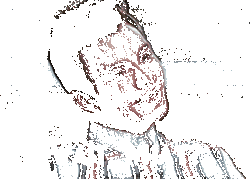

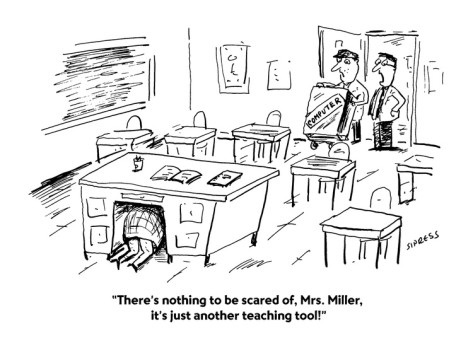

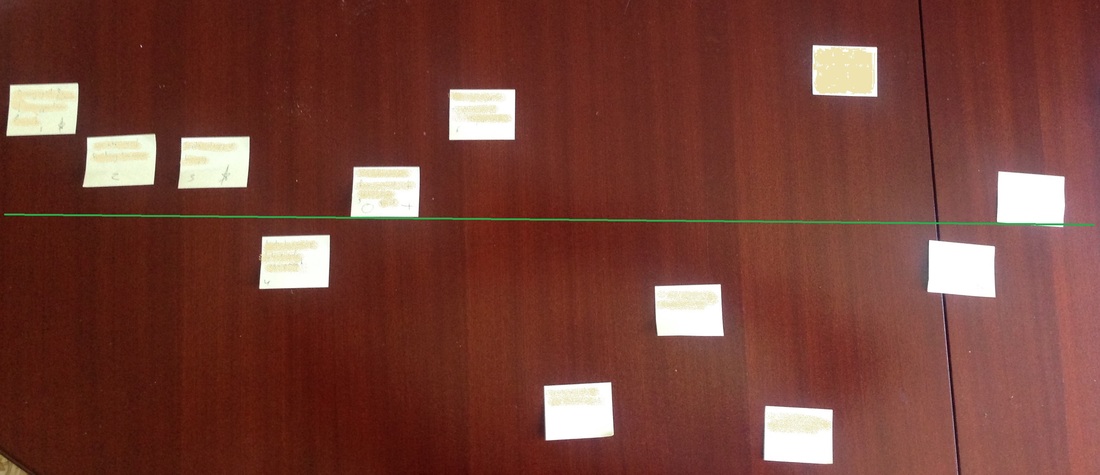

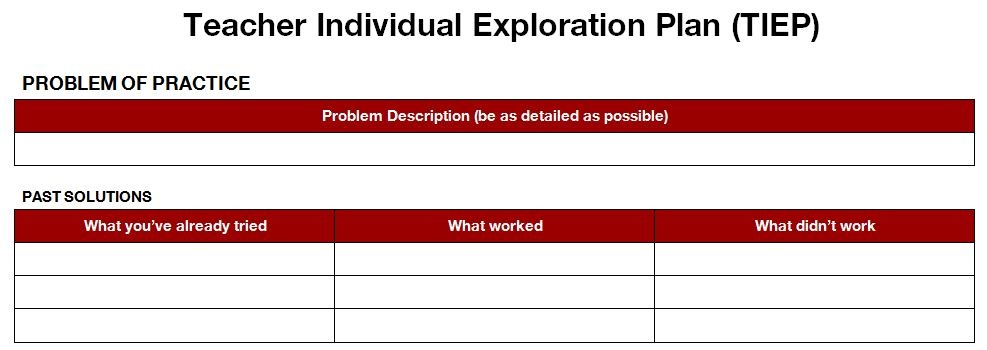

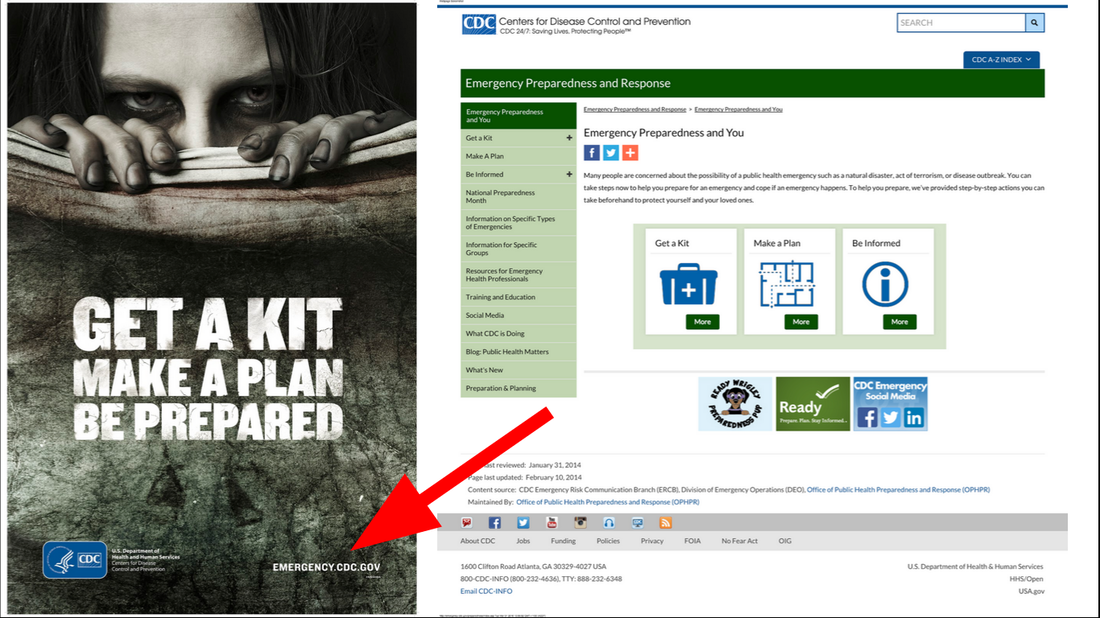
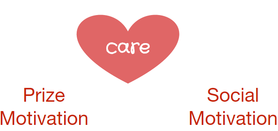
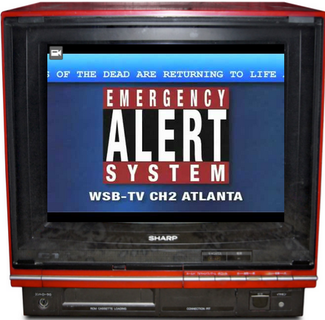
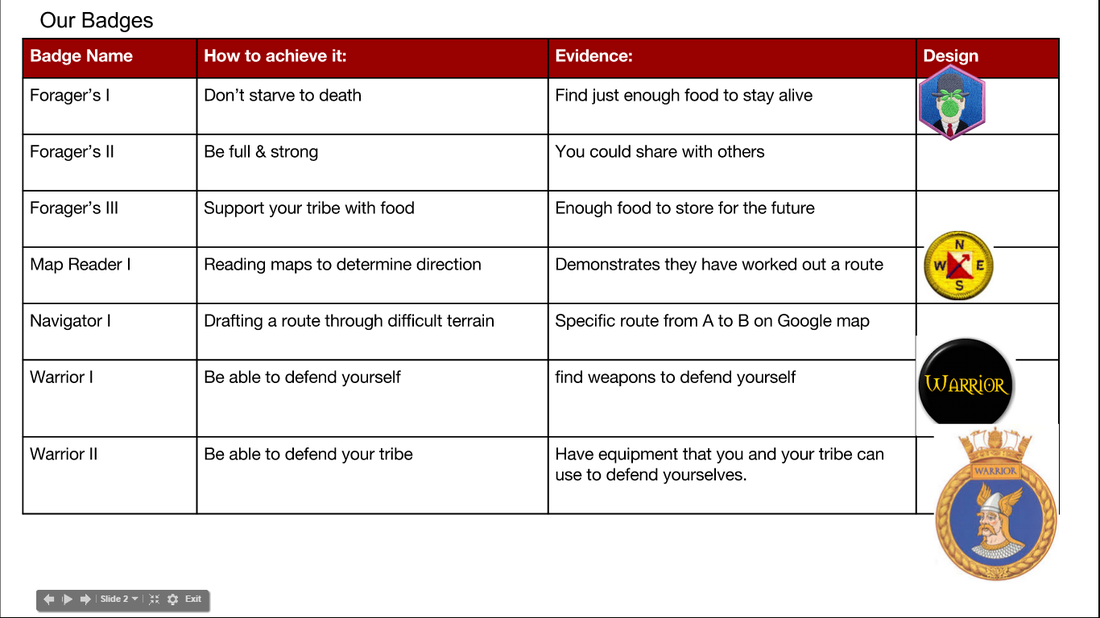
 RSS Feed
RSS Feed